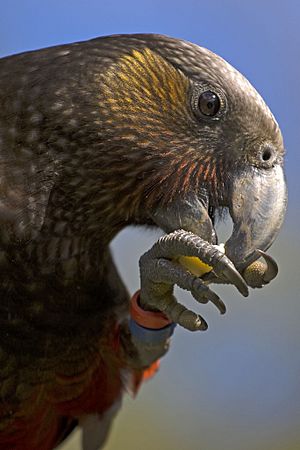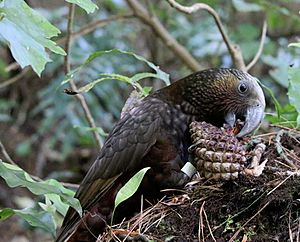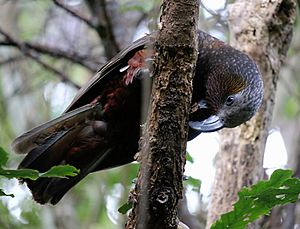New Zealand kaka facts for kids
Quick facts for kids New Zealand kaka |
|
|---|---|
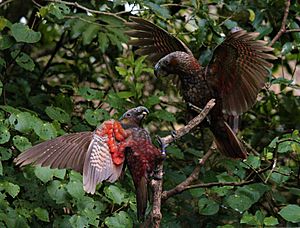 |
|
| A pair of North Island kaka in Zealandia, Wellington, New Zealand | |
| Conservation status | |
| Scientific classification | |
| Genus: |
Nestor
|
| Species: |
meridionalis
|
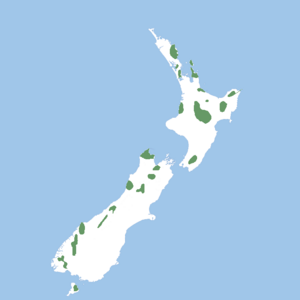 |
|
| Range in green | |
The New Zealand kaka (Māori: kākā) is a large parrot found in the native forests of New Zealand. Its scientific name is Nestor meridionalis. There are two types, or subspecies, of Kaka. Sadly, this amazing bird is endangered. It has disappeared from many places where it used to live.
Contents
About the Kaka's Name and Family
The New Zealand Kaka was first described by a German scientist, Johann Friedrich Gmelin, in 1788. The name kākā comes from the Māori language. It simply means "parrot," and might be linked to the sound "kā," which means 'to screech'.
There are two main types of Kaka:
- The North Island Kaka (Nestor meridionalis septentrionalis)
- The South Island Kaka (N. m. meridionalis)
The Kaka belongs to a group of parrots called Nestor. This group includes four species:
- The New Zealand Kaka (Nestor meridionalis)
- The kea (N. notabilis)
- The extinct Norfolk kaka (N. productus)
- The extinct Chatham kaka (N. chathamensis)
Scientists believe all these birds came from an ancient "proto-kaka" that lived in New Zealand millions of years ago. Their closest living relative is the kakapo. These birds are part of a very old parrot group called Strigopoidea. They separated from all other parrots a long, long time ago.
What Does the Kaka Look Like?
The New Zealand Kaka is a medium-sized parrot. It is about 45 cm (18 in) long. It usually weighs between 390 to 560 g (14 to 20 oz).
The Kaka is related to the kea, but it looks a bit different. Kaka have darker feathers. Their forehead and the top of their head are greyish-white. Their neck and belly are more reddish. Their wings are brownish. Both types of Kaka have feathers with patterns of brown, green, and grey. They also have bright orange and red flashes under their wings. Sometimes, you might even see Kaka with red or yellow feathers, especially on their chest!
These parrots are special because they have kept some features that most other parrots lost. This is because their family split off from other parrots about 100 million years ago.
Kaka make different sounds. You might hear a harsh ka-aa or a whistling u-wiia.
Where Do Kaka Live?
The New Zealand Kaka lives in native forests, both in lowlands and at mid-heights on mountains. Their safest homes are currently on special islands like Kapiti Island, Codfish Island, and Little Barrier Island.
They are also doing very well in the mainland island sanctuary at Zealandia in Wellington. Since Kaka were brought back to Zealandia in 2002, over 800 birds have been tagged. From Zealandia, the North Island Kaka are now moving back into Wellington city. A report from 2015 showed a big increase in their numbers over 12 years.
Kaka Behaviour
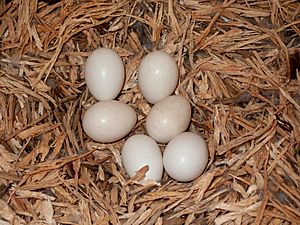
Kaka mostly live in trees. They spend their time in the middle and upper parts of the forest canopy. You can often see them flying across valleys. They also call out from the tops of very tall trees. Kaka are very social birds. They often fly in large groups, sometimes even with kea if they are in the same area.
Reproduction and Life Cycle
New Zealand Kaka build their nests inside hollow trees. The entrance hole is usually high up, about three to six metres above the ground. However, on islands where there are no predators, they might even nest at ground level. The bottom of the nest is lined with small wood chips.
Kaka can lay eggs any time between September (late winter) and March (summer). If there is a lot of fruit that year, a pair might even lay a second set of eggs. They often use the same nest hole for this second clutch. They usually lay four eggs, but sometimes they can lay up to eight. Typically, two chicks will grow up and leave the nest.
Only the female Kaka sits on the eggs. She incubates them for about 24 days. She also takes care of the baby birds in the nest. The male Kaka regularly brings her food while she is nesting. Once the chicks leave the nest, both parents help to feed them.
What Kaka Eat
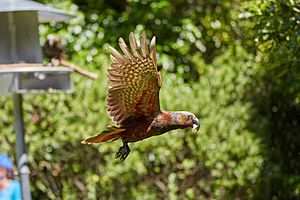
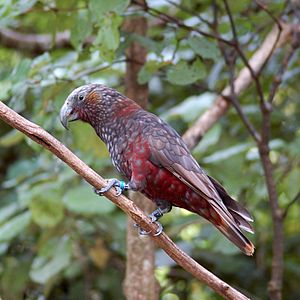
The New Zealand Kaka eats many different things. Their diet includes:
- Fruits
- Berries
- Seeds
- Flowers
- Buds
- Nectar
- Sap
- Other plant parts
- invertebrates (like insects)
They have a very strong beak. They use it to shred the cones of the kauri tree to get the seeds inside. Kaka also have a special brush-like tongue. They use this tongue to drink nectar from flowers. Their strong beak is also good for digging out grubs, like the larvae of the huhu beetle. They also use their beak to remove bark from trees to feed on the sap.
Kaka Conservation Status
The New Zealand Kaka is considered an endangered species. This means their numbers have dropped a lot. Several things have caused this decline:
- Habitat loss: Their forest homes are shrinking.
- Predators: New animals brought to New Zealand, like cats, rats, possums, and stoats, hunt Kaka.
- Competition: Other introduced insects, like wasps and bees, compete with Kaka for food like honeydew.
A close relative, the Norfolk kaka, became extinct in 1851 for similar reasons.
Predators of Kaka
Predatory mammals are a huge problem in New Zealand. They are responsible for the loss of an estimated 26 million native birds and their eggs every year.
Kaka are especially at risk because they nest in holes in trees. The mother Kaka has to stay on the nest for a long time, about 90 days, to incubate her eggs. This makes her very vulnerable to predators. Stoats are a major cause of death for nesting female Kaka, their chicks, and young birds. Possums also prey on adult females, eggs, and chicks. This predation has led to an imbalance in the age and sex of Kaka populations.
To help protect Kaka, the Department of Conservation and local groups try to control these predators. They use traps, ground baiting, and sometimes drop sodium fluoroacetate (1080) from the air. Where pest control has been done, Kaka populations have recovered significantly. For example, in Pureora Forest Park, 20 Kaka were tracked in an area treated with 1080. All 20 birds survived that season. In a nearby untreated forest, five out of nine tracked Kaka were killed by predators in the same season.
Competition for Food
Research shows that honeydew is very important for Kaka, especially for breeding birds in southern beech forests. However, introduced wasps compete with Kaka for this honeydew. It is very hard to control these wasps, which makes the Kaka's future uncertain.
Kaka and People
As the number of North Island Kaka grows in Wellington, they are visiting gardens and parks more often. This means they interact more with people. Sometimes, people feed the birds food that is not good for them, like nuts, grains, or cheese. Feeding Kaka the wrong food has caused a disease called metabolic bone disease in Kaka chicks. In 2016, 80% of the Kaka chicks being watched by the Wellington City Council died from this disease. Kaka have also started nesting in the roofs of houses.
Images for kids
See also
 In Spanish: Nestor meridionalis para niños
In Spanish: Nestor meridionalis para niños



